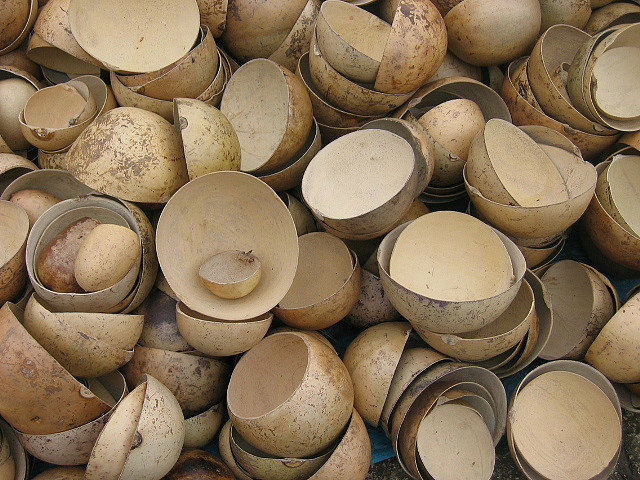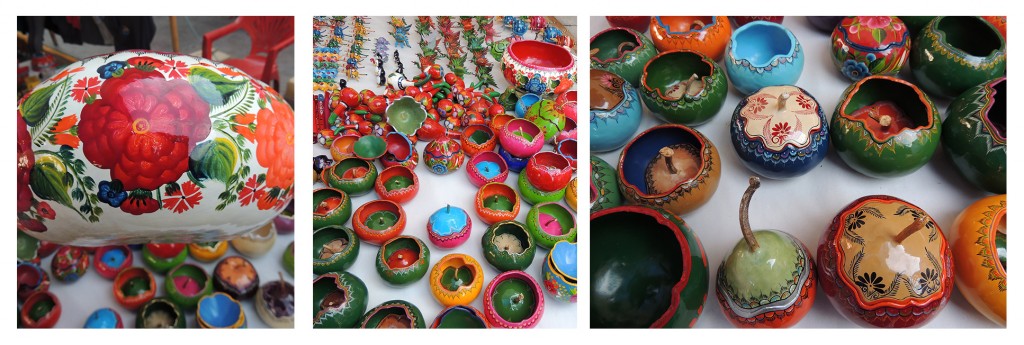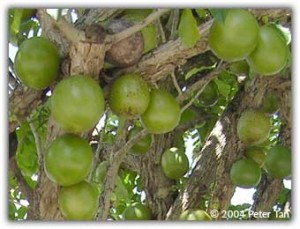The workshop was divided in 3 parts:
Pot decoration (Clay pots, Jicaras or Jicalpextle)
During this workshop we decided to look at other possibilities, that could replace clay pots and see what nature in Mexico could offer. We decided to look at Calabach tree and it’s fruits, that are used for making jicara and pumpkins that jicalpextle are made from. The reason to looking for another plant container solution, was because the clay pots became very heavy once filed with water and soil. As well, I was interested simply to look around and see what can we use that nature is already giving us.
Preparation for the hanging structure from Agave ropes making process
In a parallel with the workshop, Patrick de Koning and Gardener were preparing the knotted structure from Agave rope, for the hanging pot system. To make kids aware about the connectivity with all parts that we were using in this workshop, we had short demonstration from where the rope is made of and how can you extract fibers from Agave leave.
Calabach tree – (Crescentia cujete), tree of the family Bignoniaceae, 6 to 12 metres (20 to 40 feet) tall, that grows in Central and South America, the West Indies, and extreme southern Florida. It is often grown as an ornamental; however, it is also used in traditional systems of medicine. The calabash tree produces large spherical fruits, up to 50 cm (20 inches) in diameter, the hard shells of which are useful as bowls, cups, and other water containers when hollowed out.
 Jicara, is a cup or bowl made from fruit of the calabash tree and(especially in rural Maxico) is used to serve hot food in order to preserve its temperature. The calabash fruit grows on a tree known in Mexico as the higuera but its botanical name is Crescentia cujete. Pre-hispanic people found many uses for the calabash and modern Mexicans still use them in much the same ways. In addition to jícara bowls and cups, the calabash shell is used for musical instruments, and the pulp is sometimes made into a medicinal drink for flu and colds.
Jicara, is a cup or bowl made from fruit of the calabash tree and(especially in rural Maxico) is used to serve hot food in order to preserve its temperature. The calabash fruit grows on a tree known in Mexico as the higuera but its botanical name is Crescentia cujete. Pre-hispanic people found many uses for the calabash and modern Mexicans still use them in much the same ways. In addition to jícara bowls and cups, the calabash shell is used for musical instruments, and the pulp is sometimes made into a medicinal drink for flu and colds.
Jicalpextle is a larger bowl and its made out of Pumpkins and decorates in very specific ways.
Agave fibers
Sisal, with the botanical name Agave sisalana, is a species of Agave native to southern Mexico but widely cultivated and naturalized in many other countries. It yields a stiff fibre used in making various products. The term sisal may refer either to the plant’s common name or the fibre, depending on the context. It is sometimes incorrectly referred to as “sisal hemp”, because for centuries hemp was a major source for fibre, and others were named after it.
The sisal fibre is traditionally used for rope and twine, and has many other uses, including: paper, cloth, wall coverings, carpets, and dartboards.
Fibre is extracted by a process known as decortication, where leaves are crushed and beaten by a rotating wheel set with blunt knives, so that only fibres remain. In East Africa, where production is typically on large estates, the leaves are transported to a central decortication plant, where water is used to wash away the waste parts of the leaf.
The fibre is then dried, brushed and baled for export. Proper drying is important as fibre quality depends largely on moisture content. Artificial drying has been found to result in generally better grades of fibre than sun drying, but is not feasible in the developing countries where sisal is produced. In the drier climate of north-east Brazil, sisal is mainly grown by smallholders and the fibre is extracted by teams using portable raspadors which do not use water. Fibre is subsequently cleaned by brushing. Dry fibres are machine combed and sorted into various grades, largely on the basis of the previous in-field separation of leaves into size groups.
There are several ways for the Agave fiber extraction. In the links below you can find detailed explanations with pictures how it’s made:


